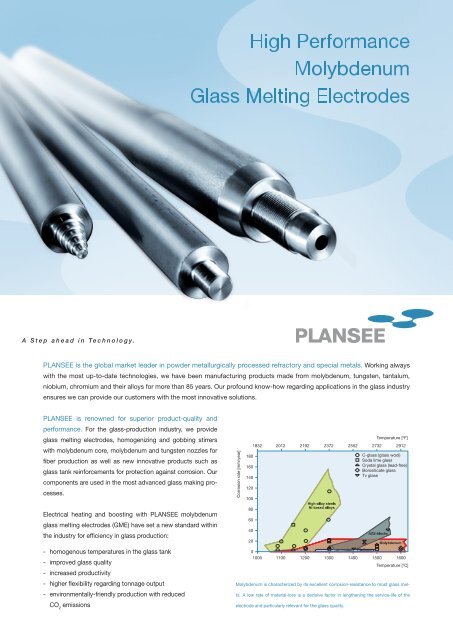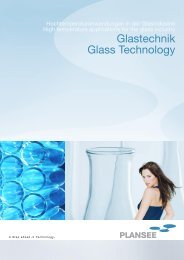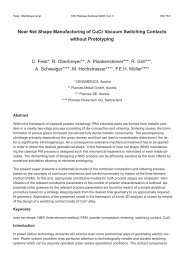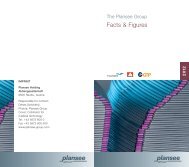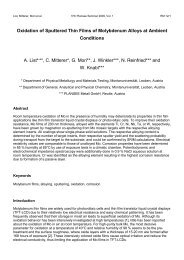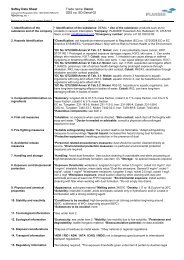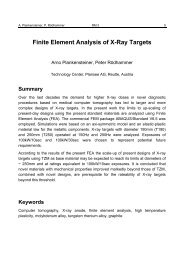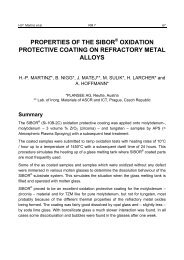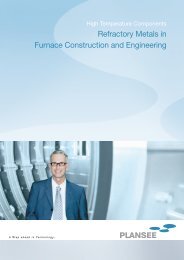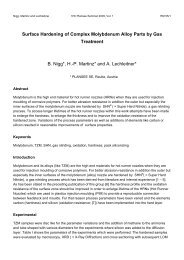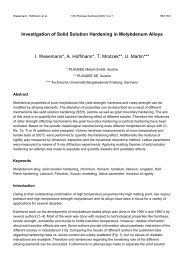Molybdenum glass melting electrodes
Molybdenum glass melting electrodes
Molybdenum glass melting electrodes
You also want an ePaper? Increase the reach of your titles
YUMPU automatically turns print PDFs into web optimized ePapers that Google loves.
High Performance<br />
<strong>Molybdenum</strong><br />
Glass Melting Electrodes<br />
PLANSEE is the global market leader in powder metallurgically processed refractory and special metals. Working always<br />
with the most up-to-date technologies, we have been manufacturing products made from molybdenum, tungsten, tantalum,<br />
niobium, chromium and their alloys for more than 85 years. Our profound know-how regarding applications in the <strong>glass</strong> industry<br />
ensures we can provide our customers with the most innovative solutions.<br />
PLANSEE is renowned for superior product-quality and<br />
performance. For the <strong>glass</strong>-production industry, we provide<br />
<strong>glass</strong> <strong>melting</strong> <strong>electrodes</strong>, homogenizing and gobbing stirrers<br />
with molybdenum core, molybdenum and tungsten nozzles for<br />
fiber production as well as new innovative products such as<br />
<strong>glass</strong> tank reinforcements for protection against corrosion. Our<br />
components are used in the most advanced <strong>glass</strong> making processes.<br />
Electrical heating and boosting with PLANSEE molybdenum<br />
<strong>glass</strong> <strong>melting</strong> <strong>electrodes</strong> (GME) have set a new standard within<br />
the industry for efficiency in <strong>glass</strong> production:<br />
- homogenous temperatures in the <strong>glass</strong> tank<br />
- improved <strong>glass</strong> quality<br />
- increased productivity<br />
- higher flexibility regarding tonnage output<br />
- environmentally-friendly production with reduced<br />
CO emissions<br />
2<br />
Corrosion rate [mm/year]<br />
rate [mm/year]<br />
180<br />
160<br />
140<br />
120<br />
100<br />
80<br />
60<br />
40<br />
20<br />
0<br />
1000<br />
180<br />
160<br />
140<br />
1832<br />
2012<br />
1100<br />
2192<br />
1200<br />
2372<br />
1300<br />
2552<br />
1400<br />
Temperature [ºF]<br />
2732 2912<br />
C-<strong>glass</strong> (<strong>glass</strong> wool)<br />
Soda lime <strong>glass</strong><br />
Crystal <strong>glass</strong> (lead-free)<br />
Borosilicate <strong>glass</strong><br />
Tv <strong>glass</strong><br />
1500 1600<br />
Temperature [ºC]<br />
<strong>Molybdenum</strong> is characterized by its excellent corrosion-resistance to most <strong>glass</strong> mel-<br />
ts. A low rate of material-loss is a decisive factor in lengthening the service-life of the<br />
Temperature [ºF]<br />
electrode 1832 and particularly 2012 relevant 2192 for the <strong>glass</strong> 2372 quality. 2552 2732 2912<br />
C-<strong>glass</strong> (<strong>glass</strong> wool)<br />
Soda lime <strong>glass</strong><br />
Crystal <strong>glass</strong> (lead free)<br />
Borosilicate <strong>glass</strong><br />
Tv <strong>glass</strong>
2<br />
Higher performance in the <strong>glass</strong> tank: PLANSEE molybdenum<br />
Wherever operating temperatures and chemical requirements exceed the limits of conventional materials such as iron, copper,<br />
or nickel – molybdenum stands out with unique properties:<br />
- high material strength at high temperatures<br />
- good electrical conductivity<br />
- excellent corrosion-resistance against molten <strong>glass</strong><br />
Physical properties of molybdenum<br />
Testing temperature 20 °C / 68 °F 1000 °C / 1832 °F<br />
Melting point [ °C / °F ] 2620 / 4748<br />
Density [g /cm 3 ] 10.2 -<br />
Thermal conductivity [ W/mK ] 141 113<br />
Specifi c electrical resistance [ Ω mm 2 /m ] 0.056 0.315<br />
Av. specifi c heat (20 °C / 68 °F to temp.) [ J/ kg K ] 254 303<br />
Av. linear thermal expansion (20 °C / 68 °F to temp.) [ 1/ K ] 5.15 x 10 -6 5.84 x 10 -6<br />
Emissivity (ground surface) 0.06 0.16<br />
Vapour pressure [mbar] 2.5 x 10 -6 ( 1500 °C / 2732 °F )<br />
Young’s modulus [GPa] 320 270
Our contribution to efficient <strong>glass</strong> <strong>melting</strong><br />
Whether you are manufacturing with fully or partially electrically-heated <strong>glass</strong> tanks or using an electrical boosting system, PLANSEE<br />
offers the ideal <strong>glass</strong> <strong>melting</strong> <strong>electrodes</strong>. High-quality <strong>glass</strong> production requires top performance from the <strong>glass</strong> <strong>melting</strong> <strong>electrodes</strong>.<br />
Whether you opt for standard or for customized dimensions and design, PLANSEE products will always provide you with:<br />
- highest material purity<br />
- optimized creep strength<br />
- high corrosion-resistance<br />
- guaranteed oxidation protection thanks to SIBOR ® coating<br />
Highest material purity<br />
Our <strong>glass</strong> <strong>melting</strong> <strong>electrodes</strong> stand out by reason of their high purity. For molybdenum PLANSEE guarantees an overall purity of<br />
99.97 %. In most cases the degree of purity is even higher (99.99 %). Traces of impurities such as carbon, nickel, and iron can<br />
lead to bubble formation or discoloration of the <strong>glass</strong> melt. PLANSEE sets up the manufacturing process with pure molybdenum<br />
oxide, without any recycled scrap. By manufacturing entirely in-house – from the conversion of oxide into metallic molybdenum<br />
powder, to pressing, sintering, deformation and finishing – PLANSEE guarantees the highest quality available.<br />
Raw material<br />
(oxide)<br />
Reduction Metal Mixing /<br />
Pressing<br />
powder Alloying<br />
Schematic process for the production of molybdenum products<br />
Chemical specifi cation<br />
for molybdenum products<br />
Element<br />
Guaranteed<br />
analysis<br />
max. [ µg /g]<br />
Typical<br />
analysis<br />
max. [ µg /g]<br />
Ag 10 < 5<br />
Al 10 < 5<br />
As 5 1<br />
Ba 5 < 1<br />
C 30 15<br />
Ca 20 5<br />
Cd 50 < 2<br />
Co 20 3<br />
Cr 20 3<br />
Cu 20 5<br />
*) Metallic purity without tungsten<br />
Element<br />
Guaranteed<br />
analysis<br />
max. [ µg /g]<br />
Sintering<br />
Deformation<br />
Typical<br />
analysis<br />
max. [ µg /g]<br />
Fe 60 30<br />
H 10 3<br />
K 10 3<br />
Mg 10 < 5<br />
Mn 2 < 1<br />
N 5 < 2<br />
Na 10 < 2<br />
Nb 10 < 5<br />
Ni 10 5<br />
O 40 15<br />
- fast delivery from stock<br />
- reliable and certified quality inspection<br />
- customized finishing<br />
Heat<br />
treatment<br />
Element<br />
Machining<br />
Joining<br />
Coating<br />
Guaranteed<br />
analysis<br />
max. [ µg /g]<br />
Quality<br />
assurance<br />
Typical<br />
analysis<br />
max. [ µg /g]<br />
P 20 < 10<br />
Pb 10 3<br />
S 10 < 2<br />
Si 30 5<br />
Ta 20 < 10<br />
Ti 10 2<br />
W 250 100<br />
Zn 10 < 5<br />
Zr 10 < 2<br />
Mo min. 99.7 %* 99.99 %*<br />
3
4<br />
Optimized creep strength<br />
The coarse grain structure of PLANSEE<br />
<strong>electrodes</strong> results in higher creep-resistance.<br />
PLANSEE <strong>electrodes</strong> minimize<br />
any bending during operation,<br />
which leads to higher efficiency, less<br />
corrosion of the surroundings and less<br />
wear of the electrode. Moreover less<br />
bending minimizes the danger of any<br />
contact of the <strong>glass</strong> <strong>melting</strong> electrode<br />
and its holder. Coarse grain-structure for best creep-resistance Fine grain-structure with low creep-resistance<br />
High corrosion resistance<br />
PLANSEE operates the world’s largest hammer forging machine for refractory metals.<br />
With a force of more than 20 t /cm 2 the <strong>glass</strong> <strong>melting</strong> <strong>electrodes</strong> are forged to final<br />
dimensions with very tight dimensional and surface tolerances. Since no additional<br />
machining is required, this results in completely closed grain-boundaries and an<br />
extremely dense surface condition, which leads in turn to unrivalled corrosion-<br />
resistance.<br />
Fact Box<br />
Creep-resistance [MPa]<br />
Creep-strength of Mo with coarse grain-structure<br />
Creep-strength of Mo with fine grain-structure<br />
1000 1200 1400 1600<br />
Temperature [ºC]<br />
Creep-resistance of molybdenum with coarse grain-structure<br />
Hammer forging machine<br />
Competitor
Guaranteed oxidation-protection through SIBOR ® coating<br />
Above 400 °C / 752 °F molybdenum starts to react with air, forming MoO 3 , which sublimates at higher temperatures as yellow<br />
smoke. During the up-tempering of the <strong>glass</strong> tank the new PLANSEE SIBOR ® coating reliably protects the <strong>electrodes</strong> against any<br />
oxidation. SIBOR ® adheres inseparably to the molybdenum by building a diffusion zone on the molybdenum surface. SIBOR ®-<br />
coated <strong>electrodes</strong> or <strong>glass</strong> tank reinforcement can easily be installed in a new or rebuilt tank. For further applications of SIBOR ®<br />
coating please refer to our SIBOR ® brochure.<br />
Glass <strong>melting</strong> <strong>electrodes</strong> with SIBOR ® coating<br />
Micrograph of a cross-section of as-coated<br />
SIBOR ® , thickness 150 µm<br />
Fact Box<br />
SEM (BS-mode) of a heat-treated SIBOR ® coating;<br />
EDX: 1 - Si (molten SIBOR ® ); 2 - Si, 4 - Mo, (Si);<br />
3, 5 - Mo<br />
PLANSEE SIBOR ® coating.<br />
Guaranteed protection.<br />
- SIBOR ® guarantees protection during the up-tempering process<br />
- SIBOR ® simplifies the installation in the <strong>glass</strong> tank which eliminates<br />
potential danger for the operators<br />
- SIBOR ® opens up new possibilities of using plate or block <strong>electrodes</strong><br />
to heighten the performance of the <strong>glass</strong> tank<br />
- SIBOR ® -coated <strong>electrodes</strong> are easy to handle<br />
<strong>Molybdenum</strong> throat channel protection fully coated<br />
with SIBOR ®<br />
SIBOR ® -coated <strong>Molybdenum</strong> plate electrode<br />
SEM (BS-mode) cross-section of an oxidized SIBOR ® -<br />
coated Mo-sample (168 h in air at 1450°C). EDX: 1 - SiO2;<br />
2 - Mo, Si; 3 - Si, Mo; 4 - Mo, Si, B; 5 - Mo, (Si); 6 - Mo<br />
5
6<br />
Fast delivery from stock<br />
All standard dimensions of <strong>glass</strong> <strong>melting</strong> <strong>electrodes</strong> are available directly from stock via PLANSEE Express. The diameters from<br />
the list below are all delivered in our special smooth-forged surface-quality with stated straightness. Metric, tapered or customerspecific<br />
threadings are available in two to three weeks. The table below shows the recommended standardized metric and tapered<br />
threads for the respective electrode diameters in order to guarantee optimal mechanical and electrical properties when in use.<br />
Diameter<br />
[mm]<br />
Diameter<br />
[inch]<br />
Production<br />
lengths<br />
[mm]<br />
(tolerance:<br />
≤ 1000 = ± 5%<br />
> 1000 = ± 50mm)<br />
Standard dimensions and thread types for <strong>glass</strong> <strong>melting</strong> <strong>electrodes</strong><br />
Straightness<br />
per m<br />
[mm]<br />
Diameter<br />
tolerance<br />
(forged<br />
surface)<br />
Average<br />
weight<br />
[kg/m]<br />
Typical threads<br />
Cylindrical Tapered<br />
31.75 1.25 2000 < 2.0 ± 0.3 8.1 M22 x 1.5 M18 x 1.5 7 / 8 - 14 UNF<br />
48 3000 < 1.5 ± 0.3 18.5 M24 x 1.5 M22 x 1.5 7 / 8 - 14 UNF<br />
1 - 8 UNC<br />
3.00 T/ft.<br />
50.8 2 2000 < 1.0 + 0 / - 0.8 20.7 M27 x 3 M24 x 1.5 1¼ - 12 UNF 19 /16 - 8 UN<br />
3.00 T/ft.<br />
54 2000 < 1.0 ± 0.4 23.4 M36 x 3 M27 x 3 1¼ - 12 UNF<br />
60 2000 < 1.0 ± 0.4 28.8 M36 x 3 M27 x 3 1¼ - 12 UNF<br />
63.5 2.5 2000 < 1.0 ± 0.4 32.3 M36 x 3 1¼ - 12 UNF 19 /16 - 8 UN<br />
3.00 T/ft.<br />
70 2000 < 2.5 ± 1.0 39.3 M42 x 3 1½ - 12 UNF<br />
76.2 3 2000 < 2.5 ± 1.0 46.5 M42 x 3 1½ - 12 UNF<br />
80 2000 < 2.5 ± 1.0 51.3 M42 x 3 1½ - 12 UNF<br />
90 2000 < 2.5 ± 1.0 64.9 M58 x 3 2 ¼ - 8 UNF<br />
1 15 /16 - 8<br />
UN 3.00<br />
T/ft<br />
101.2 4 2000 < 2.5 ± 1.0 82.0 M58 x 3 2 ¼ - 8 UNF 2 3 /8 - 6 UN<br />
3.00 T/ft<br />
1 15 /16 - 8<br />
UN 3.00<br />
T/ft<br />
2 3 /8 - 6 UN<br />
3.00 T/ft<br />
3 - 6 UN<br />
3.00 T/ft<br />
Special thread dimensions according to our customers‘ specifications, as well as different length and diameter tolerances are<br />
available. Quotations and delivery times on request.
Reliable and certified quality inspection<br />
To guarantee top performance our inspection routines include chemical analysis and dimensional control of threading, diameter,<br />
straightness, and length. Additionally, each electrode is ultrasonically tested to detect even the smallest cracks and to minimize<br />
the risk of breaking.<br />
Our company is certified according to ISO 9001. Moreover, we are capable of carrying out chemical analyses as well as investigations<br />
of physical properties in our authorized and certified laboratories in accordance with customers’ requests.<br />
Customized finishing<br />
PLANSEE offers customer-specific threadings, cooling drills, and customized coatings such as NICROM ® , a steam-resistant<br />
inside coating to minimize steam boiling corrosion.<br />
Different electrode designs, such as block and plate <strong>electrodes</strong> in various dimensions, can be manufactured. These designs are<br />
available with or without SIBOR ® coating for oxidation-protection during up-tempering of the <strong>glass</strong> tank.<br />
Quality inspection for <strong>glass</strong> <strong>melting</strong> <strong>electrodes</strong>:<br />
Ultra-sonic testing Straightness Threading<br />
7
8<br />
Application Information<br />
Over the years, PLANSEE has gained considerable insight into factors critical for success in the <strong>glass</strong> industry. With profound<br />
application know-how we strengthen our customer’s competitiveness and improve performance levels. For the correct operation<br />
of molybdenum <strong>glass</strong> <strong>melting</strong> <strong>electrodes</strong> please take careful note of the following information.<br />
No lubricants in threadings<br />
Lubricants are not necessary for the connection of standard threads. If connected properly, the threads will not jam and the<br />
shoulders will fit precisely. Depending on their type and composition, lubricants can even cause problems. Organic lubricants<br />
burn at high temperatures and the carbon released in this process can diffuse into the molybdenum. For applications in the field<br />
of the <strong>glass</strong> industry only small amounts of carbon impurities are permissible, as carbon can cause CO and CO bubbles to form.<br />
2<br />
Furthermore, lubricants can have an insulating effect which hinders the flow of current.<br />
Connection via shoulder contact<br />
To ensure optimum flow of current, the <strong>glass</strong> <strong>melting</strong> <strong>electrodes</strong> have to be connected via shoulder contact. The shoulder and<br />
threading of the <strong>electrodes</strong> have to be free of any cracks, scratches and marks to ensure a tight contact. PLANSEE has adapted<br />
the design of tapered threads to guarantee tight contact as shown below:<br />
Standard tapered thread without shoulder contact. Tapered thread with shoulder contact for a <strong>glass</strong> <strong>melting</strong> electrode application
Threading recommendations<br />
Length and diameter of the threading have to be adapted<br />
on the diameter of the electrode. The threading has to absorb<br />
the bending strength of the electrode. General rule is<br />
that the diameter of the threading should be approximately<br />
20 mm less than the diameter of the electrode to ensure<br />
a large sufficient contact. The length and diameter of the<br />
threading should be approximately equal.<br />
Recommended PLANSEE standard threadings are.<br />
Thread<br />
Length of<br />
male thread<br />
A [mm]<br />
Recommended cylindrical thread design for <strong>glass</strong> <strong>melting</strong> <strong>electrodes</strong><br />
Metric threads UN threads<br />
Depth of<br />
female thread<br />
B [mm]<br />
Chamfer<br />
C [mm]<br />
Thread<br />
Length of<br />
male thread<br />
A [mm]<br />
Depth of<br />
female thread<br />
B [mm]<br />
M 18 x 1.5 20.5 22.5 1.5 7/8 - 14 UNF 25.5 27.5 2.0<br />
M 22 x 1.5 24.5 26.5 1.5 1 1/4 - 12 UNF 29.0 31.0 2.5<br />
M 24 x 1.5 26.5 28.5 1.5 1 1/2 - 12 UNF 34.0 36.0 2.5<br />
Chamfer<br />
C [mm]<br />
M 27 x 3 31.5 33.5 3.0 2 1/4 - 8 UNF 51.0 53.0 3.5<br />
M 36 x 3 33.5 35.5 3.0<br />
M 42 x 3 38.5 40.5 3.0<br />
M 58 x 3 51.0 53.0 3.0<br />
Regarding bending strength tapered threads are in general less favourable than metric threads.<br />
Turning of the electrode at regular intervals<br />
The flow of the <strong>glass</strong> around the <strong>electrodes</strong> leads to an ununiform wear, mainly this causes an elliptical cross section by erosion<br />
processes. This elliptical shape has much less creep-resistance than round shaped <strong>electrodes</strong> and the bending leads to a breaking<br />
of the electrode. This mechanism of becoming elliptical can be avoid by turning the electrode in regular intervals. To prevent<br />
the threads from becoming loose during turning process the <strong>electrodes</strong> have to be turned in a clockwise direction only.<br />
B<br />
D<br />
A<br />
C<br />
9
10<br />
Temperature [˚C]<br />
Application Information<br />
Sealing by <strong>glass</strong>ification<br />
For the installation of the electrode it is recommended to first push it into the <strong>glass</strong> melt and then pull it back into the electrode<br />
holder, while turning it continuously in a clockwise direction. Through cooling of the electrode holder, the <strong>glass</strong> layer solidifies,<br />
thus providing protection against diffusion. Before inserting an extension electrode, the cooling of the holder should be slightly<br />
reduced so as to promote <strong>melting</strong> of the solidified <strong>glass</strong> layer.<br />
Sufficient cooling<br />
Sufficient cooling of the electrode holder is of the utmost importance. At high temperatures certain atoms – e.g. iron and nickel<br />
atoms – diffuse out of the electrode holder into the molybdenum of the electrode, forming brittle and low-<strong>melting</strong> phases. In<br />
order to avoid such problems the electrode holder, and consequently the <strong>glass</strong> <strong>melting</strong> electrode as well, must be cooled<br />
sufficiently, and the electrode must be completely immersed in the <strong>glass</strong> melt. Otherwise, there can occur a <strong>melting</strong> of the<br />
solidified <strong>glass</strong> layer in the gap, and this can in turn affect the atom-diffusion process described above, by bringing about a direct<br />
contact between the <strong>glass</strong> <strong>melting</strong> electrode and its holder. Frequent monitoring of the electrical values is important in order<br />
to ensure punctual replenishment and thus avoid overheating. In addition, electrode-erosion is influenced by temperature: high<br />
temperatures result in increased electrode-erosion and thus in reduced service-life.<br />
0 0<br />
2700 2700<br />
Temperature [˚C]<br />
2500 2500<br />
2300 2300<br />
2100 2100<br />
1900 1900<br />
1700 1700<br />
1538 / 2800 1538 / 2800<br />
1500 1500<br />
1394 / 2541 1394 / 2541<br />
1300 1300<br />
1100 1100<br />
900 912 900/<br />
1674<br />
700 700<br />
912 /<br />
1674<br />
Atomic Atomic percent percent molybdenum molybdenum<br />
10 10 20 20 30 3040 4050 50 60 60 70 80 70 90 80 100 90 100<br />
4892 4892<br />
2623 / 4753 2623 / 4753<br />
4532 4532<br />
1611 / 2932 1611 / 2932<br />
1488 / 2710 1488 / 2710<br />
1370 / 1370 /<br />
1449 / 2640 1449 / 2640 2498 2498<br />
1235 / 2255 1235 / 2255<br />
1200 / 2192 1200 / 2192<br />
927 / 1700 927 / 1700<br />
0 010 1020 2030 3040 4050 5060 6070 7080 809090 100 100<br />
Fe Fe Weight Weight percent percent molybdenum molybdenum<br />
Mo Mo<br />
Binary phase diagram of Mo/Fe<br />
Temperature [˚F]<br />
4172 4172<br />
3812 3812<br />
3452 3452<br />
3092 3092<br />
2732 2732<br />
2372 2372<br />
2012 2012<br />
1652 1652<br />
1292 1292<br />
Temperature [˚F]<br />
Temperature [˚C]<br />
0 0<br />
2700 2700<br />
Temperature [˚C]<br />
2500 2500<br />
2300 2300<br />
2100 2100<br />
1900 1900<br />
1700 1700<br />
1500 1500 1455 / 2651 1455 / 2651<br />
1300 1300<br />
1100 1100<br />
900<br />
700<br />
900<br />
700<br />
Atomic Atomic percent percent molybdenum molybdenum<br />
10 10 20 20 30 3040 4050 50 60 60 70 80 70 90 80 100 90 100<br />
4892 4892<br />
2623 / 4753 2623 / 4753<br />
4532 4532<br />
870 / 1598 870 / 1598<br />
1362 / 2484 1362 / 2484<br />
1317 / 2403 1317 / 2403<br />
910 / 1670 910 / 1670<br />
0 010 1020 2030 3040 4050 5060 6070 7080 809090 100 100<br />
Ni Ni Weight Weight percent percent molybdenum molybdenum<br />
Mo Mo<br />
Binary phase diagram of Mo/Ni<br />
Temperature [˚F]<br />
4172 4172<br />
3812 3812<br />
3452 3452<br />
3092 3092<br />
2732 2732<br />
2372 2372<br />
2012 2012<br />
1652 1652<br />
1292 1292<br />
Reducing the current surface-density<br />
A current surface-density of 1 to maximum 2 A/cm2 is acceptable for <strong>glass</strong> <strong>melting</strong> <strong>electrodes</strong>. Corrosion increases drastically in<br />
step with increasing surface current-density. A good possibility to minimize this strain is to increase the surface itself by choosing<br />
a greater diameter or changing, especially in the feeder section, to plate or block <strong>electrodes</strong>.<br />
Temperature [˚F]
Operating length<br />
The operating length of the electrode is another decisive factor regarding the service life. The longer the operating electrode, the<br />
higher the danger of bending. On the contrary, if the operating length becomes too short, higher corrosion of the bricks in the<br />
surrounding of the electrode occurs and also an overheating of the electrode holder can be caused.<br />
Correct surface current-density distribution with sufficient immerson Incorrect surface current-density distribution<br />
Choice of refining agent<br />
Formulae for length and diameter calculation for <strong>glass</strong> <strong>melting</strong> <strong>electrodes</strong><br />
A active [cm 2 ] calculated active electrode area in the tank<br />
l [A] necessary current per electrode<br />
J [A /cm 2 ] chosen surface current density (recommended: 1A/cm 2 , max. 2A/cm 2 )<br />
V [ ]<br />
The refining agent and its concentration in the <strong>glass</strong> melt<br />
have a large influence on the total corrosion of the electrode.<br />
Minimizing the concentration or changing to a less corrosive<br />
system can increase the service life of the molybdenum<br />
Ratio of active length to electrode diameter (recommended: 12 to 16)<br />
[according to Glenn J. Conger, Owens Illinois Inc. Toledo, Ohio]<br />
[cm] electrode diameter<br />
ℓ active [cm] active electrode length in the tank<br />
11<br />
10<br />
[mg/cm²h]<br />
9<br />
loss<br />
8<br />
7<br />
significantly. Weight<br />
6<br />
5<br />
4<br />
3<br />
2<br />
1<br />
with insufficient immerson<br />
0<br />
0 0.1 0.2 0.3 0.4 0.5 0.6 0.7 0.8 0.9 1.0<br />
Concentration of refining agent [%]<br />
Material consumption due to refining agents (J. Vach and V. Süsser: Schmelzen von<br />
Gläsern in kleinen elektrischen Öfen, 46. Glastechnische Tagung, Wiesbaden, 1972)<br />
11
Close to the customer - our global network<br />
PLANSEE manufactures and markets its products worldwide. Production sites in Europe, USA and Japan and a global network<br />
of sales subsidiaries and sales partners, enable outstanding customer service and product quality delivered by local teams.<br />
Stronger than any alliance and more diversified than single producers, PLANSEE is the most reliable source for high performance<br />
components made of refractory metals.<br />
For more information and local contacts please visit our website:<br />
www.plansee.com<br />
We reserve the right to make technical changes for improvement of the product.<br />
70001011 - 718 TI EN 05.09 (1.500)


